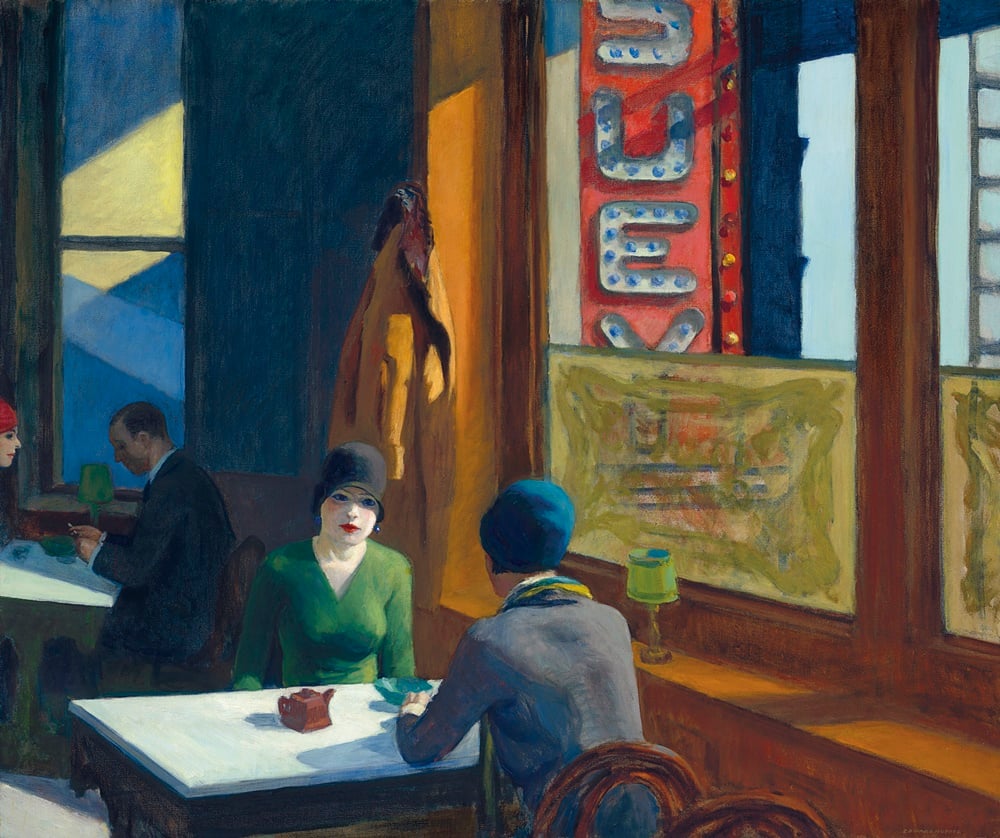Auctions
New Auction Records for Hopper and de Kooning Lead Christie’s Booming $318 Million Barney Ebsworth Sale
Is the Hopper masterpiece headed to a museum?

Is the Hopper masterpiece headed to a museum?

Eileen Kinsella

The sale of late businessman Barney Ebsworth’s private collection at Christie’s New York pulled in a total of $317.8 million, easily exceeding the estimate of about $258.3 million.
Many experts called the event a “once in a lifetime” opportunity to acquire some of the finest examples of American Modernism, thanks to Ebsworth’s longstanding reputation as a connoisseur in the field—and indeed that proved to be the case.
Of 42 lots offered, 37 were sold, or 88 percent. By value, the auction was 99 percent sold. As expected, the star lot was Edward Hopper’s Chop Suey (1929), one of the last major Hoppers from the 1920s remaining in private hands, estimated at $70 million to $100 million.
Auctioneer Jussi Pylkkanen opened the bidding at around $48 million and a bidding war soon erupted between Loic Gouzer, co-chairman of Christie’s Americas’ postwar and contemporary art department, and Eric Widing, Christie’s deputy chairman. The fact that specialists from the contemporary art realm and the American art realm went head to head is a sign of the work’s broad appeal.
The painting, which was ultimately hammered down for $85 million to Gouzer’s buyer, set a record not only for the artist but for the auction house’s entire category of “American Art,” which Christie’s roughly defines as pre-war artists. With premium, the final price was $91.9 million, far eclipsing the previous Hopper record of $40.5 million, paid for East Wind Over Weehawken (1934) at Christie’s in 2013.
Who bought Chop Suey? Christie’s wasn’t saying. But at a post-sale press conference, auction house chairman Marc Porter seemed to hint that it could be an institution, adding with a broad smile that the house “hopes to see it hanging again soon.”
Other top lots include included Willem de Kooning’s Woman as Landscape (1954–55), which was estimated at $60 million to $90 million. As far as provenance goes, this painting packed a double punch: Not only had it never appeared at auction before, but Ebsworth acquired it from actor and fellow collector Steve Martin back in 1991.
Bidding opened at $50 million and the work was hammered down to Christie’s specialist Alex Rotter for $61 million, or $68.9 million with premium, marking a new auction record for de Kooning. The previous record of $66.3 million for an untitled painting from 1977 was set at Christie’s in November 2016. (The artist’s prices have reached far higher on the private market: Ken Griffin reportedly bought de Kooning’s 1955 Interchange from David Geffen for $300 million in 2016.)
Even though records tumbled for the top works on offer, the bidding nonetheless felt measured compared to the more heated bidding wars often seen at this level of the market.
Jackson Pollock’s Composition with Red Strokes (1950), estimated at $50 million to $70 million, sold for $55.4 million with premium to a woman in the front of the room after bidding opened at $40 million.
The estimate of $12 million–$16 million on Joan Mitchell’s abstract canvas 12 Hawks at 3 O’Clock (1960) put it within reach of a new record for the artist, which was set at Christie’s this past May when Blueberry (1969) sold for $16.6 million. The painting was formerly owned by artist Sam Francis, who acquired it directly from Mitchell. Ebsworth bought it at a Christie’s auction in 1997 for just $310,500.
Bidding was lively and the work eventually sold for $14 million to Rotter’s buyer bidding on the phone.
Also among the highest estimated lots was a Franz Kline abstract, titled simply Painting, and dated 1954. It was estimated at $5 million to $7 million but failed to excite any enthusiasm in the room. It was instead handed over to an absentee bid, which Pylkkanen said was $3.75 million, or $4.5 million with premium.
The sale opened with a painting by Georgia O’Keeffe, an artist Ebsworth knew well and who even acted as a witness at his second wedding, which took place at her home in Abiquiu, New Mexico. O’Keeffe’s Horn and Feather (1937), estimated at $700,000 to $1 million, sold under expectations at $500,000, however. (The final price with premium came in at about $613,000).
The action often felt particularly intense at the lower price points and for some of the less well-known names. A painting by Francis Criss, Melancholy Interlude (1939), sold for $348,500, more than double the high estimate. Similarly, Suzy Frelinghuysen’s Composition (1943) sold for $552,500 against an estimate of $120,000 to $180,000. And Leon Polk-Smith’s Black Over Red (1960) leapt to $336,500 compared with an estimate of $50,000 to $70,000.
Ebsworth, who was born in St. Louis, Missouri, in 1934, made his fortune in cruise lines and the luxury travel business. He was also an angel investor in the retail phenomenon Build a Bear Workshop. His passion for art originated during his time with the US Army in France in 1956, during which time he frequented the Louvre.
At the post-sale press conference tonight, Widing noted that Ebsworth was a great student who, when making acquisitions, “looked at everything and read everything.”